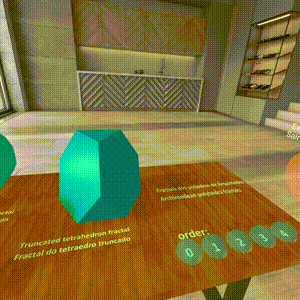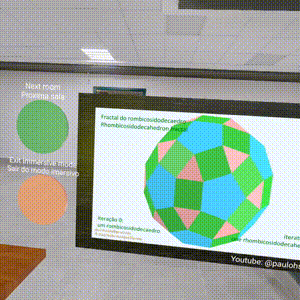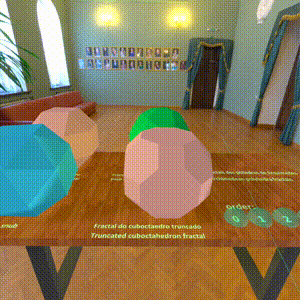Visualization of polyhedra with Augmented Reality (AR) and Virtual Reality (VR) in A-frame
author: Paulo Henrique Siqueira - Universidade Federal do Paraná
contact: paulohscwb@gmail.com
versão em português
 Archimedean polyhedra fractals
Archimedean polyhedra fractals
Using the same principle as the construction of the Sierpinski triangle or the Koch curve, we can construct fractals from other regular polygons. When these polygons form a polyhedron, we have the construction of a fractal polyhedron.
Augmented Reality | 3D Models | Home
Immersive rooms
🔗 room 1 | 🔗 room 2 | 🔗 room 3 | 🔗 room 4 | 🔗 room 5



Augmented Reality
To view fractal polyhedra in AR, simply visit the pages indicated in the 3D solid models using any browser with a webcam device (smartphone, tablet or notebook).
Access to the VR sites is done by clicking on the blue circle that appears on top of the marker.


3D models
1. Cuboctahedron fractal


Applying the construction Sierpinski principle to square faces of the cuboctahedron, we obtain a cuboctahedron fractal. In the first order of fractal construction, we construct a new solid at each vertex of the original polyhedron. In this example, we have representations of the solid in orders 0, 1, 2 and 3.
| order | polyhedra | faces | edges | vertices |
|---|---|---|---|---|
| 0 | 1 | 14 | 24 | 12 |
| 1 | 12 | 168 | 288 | 144 |
| 2 | 144 | 2016 | 3456 | 1728 |
| 3 | 1728 | 24192 | 41472 | 20736 |
2. Icosidodecahedron fractal


Applying the construction principle of the Koch curve to triangular faces of the icosidodecahedron, we obtain a icosidodecahedron fractal. In the first order of fractal construction, we construct a new solid at each triangular face of the original polyhedron. In this example, we have representations of the solid in orders 0, 1, 2 and 3.
| order | polyhedra | faces | edges | vertices |
|---|---|---|---|---|
| 0 | 1 | 32 | 60 | 30 |
| 1 | 21 | 672 | 1260 | 630 |
| 2 | 441 | 14112 | 26460 | 13230 |
| 3 | 9261 | 296352 | 555660 | 277830 |
3. Rhombicosidodecahedron fractal


Applying the construction principle of the Koch curve to pentagonal faces of the rhombicosidodecahedron, we obtain a rhombicosidodecahedron fractal. In the first order of fractal construction, we construct a new solid at each pentagonal face of the original polyhedron. In this example, we have representations of the solid in orders 0, 1, 2 and 3.
| order | polyhedra | faces | edges | vertices |
|---|---|---|---|---|
| 0 | 1 | 62 | 120 | 60 |
| 1 | 13 | 806 | 1560 | 780 |
| 2 | 169 | 10478 | 20280 | 10140 |
| 3 | 2197 | 136214 | 263640 | 131820 |
4. Rhombicuboctahedron fractal


Applying the construction principle of the Koch curve to triangular faces of the rhombicuboctahedron, we obtain a rhombicuboctahedron fractal. In the first order of fractal construction, we construct a new solid at each triangular face of the original polyhedron. In this example, we have representations of the solid in orders 0, 1, 2 and 3.
| order | polyhedra | faces | edges | vertices |
|---|---|---|---|---|
| 0 | 1 | 26 | 48 | 24 |
| 1 | 9 | 234 | 432 | 216 |
| 2 | 81 | 2106 | 3888 | 1944 |
| 3 | 729 | 18954 | 34992 | 17496 |
5. Snub cube fractal


Applying the construction principle of the Koch curve to square faces of the snub cube, we obtain a snub cube fractal. In the first order of fractal construction, we construct a new solid at each square face of the original polyhedron. In this example, we have representations of the solid in orders 0, 1, 2, 3 and 4.
| order | polyhedra | faces | edges | vertices |
|---|---|---|---|---|
| 0 | 1 | 38 | 60 | 24 |
| 1 | 7 | 266 | 420 | 168 |
| 2 | 49 | 1862 | 2940 | 1176 |
| 3 | 343 | 13034 | 20580 | 8232 |
| 4 | 2401 | 91238 | 144060 | 57624 |
6. Snub dodecahedron fractal


Applying the construction principle of the Koch curve to pentagonal faces of the snub dodecahedron, we obtain a snub dodecahedron fractal. In the first order of fractal construction, we construct a new solid at each pentagonal face of the original polyhedron. In this example, we have representations of the solid in orders 0, 1, 2 and 3.
| order | polyhedra | faces | edges | vertices |
|---|---|---|---|---|
| 0 | 1 | 92 | 150 | 60 |
| 1 | 13 | 1196 | 1950 | 780 |
| 2 | 169 | 15548 | 25350 | 10140 |
| 3 | 2197 | 202124 | 329550 | 131820 |
7. Truncated cuboctahedron fractal


Applying the construction principle of the Koch curve to square faces of the truncated cuboctahedron, we obtain a truncated cuboctahedron fractal. In the first order of fractal construction, we construct a new solid at each square face of the original polyhedron. In this example, we have representations of the solid in orders 0, 1, 2 and 3.
| order | polyhedra | faces | edges | vertices |
|---|---|---|---|---|
| 0 | 1 | 26 | 72 | 48 |
| 1 | 13 | 338 | 936 | 624 |
| 2 | 169 | 4394 | 12168 | 8112 |
| 3 | 2197 | 57122 | 158184 | 105456 |
8. Truncated cube fractal


Applying the construction principle of the Koch curve to triangular faces of the truncated cube, we obtain a truncated cube fractal. In the first order of fractal construction, we construct a new solid at each triangular face of the original polyhedron. In this example, we have representations of the solid in orders 0, 1, 2 and 3.
| order | polyhedra | faces | edges | vertices |
|---|---|---|---|---|
| 0 | 1 | 14 | 36 | 24 |
| 1 | 9 | 126 | 324 | 216 |
| 2 | 81 | 1134 | 2916 | 1944 |
| 3 | 729 | 10206 | 26244 | 17496 |
9. Truncated dodecahedron fractal


Applying the construction principle of the Koch curve to triangular faces of the truncated dodecahedron, we obtain a truncated dodecahedron fractal. In the first order of fractal construction, we construct a new solid at each triangular face of the original polyhedron. In this example, we have representations of the solid in orders 0, 1, 2 and 3.
| order | polyhedra | faces | edges | vertices |
|---|---|---|---|---|
| 0 | 1 | 32 | 150 | 60 |
| 1 | 21 | 672 | 3150 | 1260 |
| 2 | 441 | 14112 | 66150 | 26460 |
| 3 | 9261 | 296352 | 1389150 | 555660 |
10. Truncated icosahedron fractal


Applying the construction principle of the Koch curve to pentagonal faces of the truncated icosahedron, we obtain a truncated icosahedron fractal. In the first order of fractal construction, we construct a new solid at each pentagonal face of the original polyhedron. In this example, we have representations of the solid in orders 0, 1, 2 and 3.
| order | polyhedra | faces | edges | vertices |
|---|---|---|---|---|
| 0 | 1 | 32 | 90 | 60 |
| 1 | 13 | 416 | 1170 | 780 |
| 2 | 169 | 5408 | 15210 | 10140 |
| 3 | 2197 | 70304 | 197730 | 131820 |
11. Truncated icosidodecahedron fractal


Applying the construction principle of the Koch curve to decagonal faces of the truncated icosidodecahedron, we obtain a truncated icosidodecahedron fractal. In the first order of fractal construction, we construct a new solid at each decagonal face of the original polyhedron. In this example, we have representations of the solid in orders 0, 1, 2, 3 and 4.
| order | polyhedra | faces | edges | vertices |
|---|---|---|---|---|
| 0 | 1 | 62 | 180 | 120 |
| 1 | 13 | 806 | 2340 | 1560 |
| 2 | 169 | 10478 | 30420 | 20280 |
| 3 | 2197 | 136214 | 395460 | 263640 |
| 4 | 2401 | 33614 | 86436 | 57624 |
12. Truncated octahedron fractal


Applying the construction principle of the Koch curve to square faces of the truncated octahedron, we obtain a truncated octahedron fractal. In the first order of fractal construction, we construct a new solid at each square face of the original polyhedron. In this example, we have representations of the solid in orders 0, 1, 2, 3 and 4.
| order | polyhedra | faces | edges | vertices |
|---|---|---|---|---|
| 0 | 1 | 14 | 36 | 24 |
| 1 | 7 | 98 | 252 | 168 |
| 2 | 49 | 686 | 1764 | 1176 |
| 3 | 343 | 4802 | 12348 | 8232 |
| 4 | 343 | 4802 | 12348 | 8232 |
13. Truncated tetrahedron fractal


Applying the construction Sierpinski principle to each triangular face vertex of the truncated tetrahedron, we obtain a truncated tetrahedron fractal. In the first order of fractal construction, we construct a new solid at each vertex of the original polyhedron. In this example, we have representations of the solid in orders 0, 1, 2 and 3.
| order | polyhedra | faces | edges | vertices |
|---|---|---|---|---|
| 0 | 1 | 8 | 18 | 12 |
| 1 | 12 | 96 | 216 | 144 |
| 2 | 144 | 1152 | 2592 | 1728 |
| 3 | 1728 | 13824 | 31104 | 20736 |
14. Menger sponge: Snub cube


Applying the construction principle of the Sierpinski carpet to the 6 square faces of the snub cube, we obtain a fractal snub cube. In the first order of construction of the fractal, we construct 8 new solids on each square face of the original polyhedron, all with ⅓ the measurement of the snub cube’s edge. In this example, we have representations of the solid in orders 0, 1, 2 and 3.
15. Menger's Cross - Jerusalem: Snub cube v1


Consider a snub cube. We can increase the edge sizes of the corner snub cubes and decrease the edge sizes of the intermediate snub cubes to reveal a cross. In this version, we have 8 homothetic snub cubes with an aspect ratio of ⅖ and 12 homothetic snub cubes with a proportion of ⅕.
16. Menger's Cross - Jerusalem: Snub cube v2


Consider a snub cube. We can increase the edge sizes of the corner snub cubes and decrease the edge sizes of the intermediate snub cubes to reveal a cross. In this version, we have 8 homothetic snub cubes with an aspect ratio of √2 - 1 and 12 homothetic snub cubes with a proportion of (√2 - 1)².
17. Mosely snowflake: Snub cube


The Mosely snowflake is a type of Sierpinski-Menger fractal obtained in two variants by the operation used in creating the Sierpinski-Menger snowflake. In this case, we removed eight corner snub cubes and the center snub cube in each iteration.
18. Menger sponge: Truncated cube


Applying the construction principle of the Sierpinski carpet to the 6 octagonal faces of the truncated cube, we obtain a fractal truncated cube. In the first order of construction of the fractal, we construct 8 new solids on each octagonal face of the original polyhedron, all with ⅓ the measurement of the truncated cube’s edge. In this example, we have representations of the solid in orders 0, 1, 2 and 3.
19. Menger's Cross - Jerusalem: Truncated cube v1


Consider a truncated cube. We can increase the edge sizes of the corner truncated cubes and decrease the edge sizes of the intermediate truncated cubes to reveal a cross. In this version, we have 8 homothetic truncated cubes with an aspect ratio of ⅖ and 12 homothetic truncated cubes with a proportion of ⅕.
20. Menger's Cross - Jerusalem: Truncated cube v2


Consider a truncated cube. We can increase the edge sizes of the corner truncated cubes and decrease the edge sizes of the intermediate truncated cubes to reveal a cross. In this version, we have 8 homothetic truncated cubes with an aspect ratio of √2 - 1 and 12 homothetic truncated cubes with a proportion of (√2 - 1)².
21. Mosely snowflake: Truncated cube


The Mosely snowflake is a type of Sierpinski-Menger fractal obtained in two variants by the operation used in creating the Sierpinski-Menger snowflake. In this case, we removed eight corner truncated cubes and the center truncated cube in each iteration.
22. Menger sponge: Rhombicuboctahedron


Applying the construction principle of the Sierpinski carpet to 6 square faces of the rhombicuboctahedron, we obtain a fractal rhombicuboctahedron. In the first order of construction of the fractal, we construct 8 new solids on square faces of the original polyhedron, all with ⅓ the measurement of the rhombicuboctahedron’s edge. In this example, we have representations of the solid in orders 0, 1, 2 and 3.
23. Menger's Cross - Jerusalem: Rhombicuboctahedron v1


Consider a rhombicuboctahedron. We can increase the edge sizes of the corner rhombicuboctahedrons and decrease the edge sizes of the intermediate rhombicuboctahedrons to reveal a cross. In this version, we have 8 homothetic rhombicuboctahedrons with an aspect ratio of ⅖ and 12 homothetic rhombicuboctahedrons with a proportion of ⅕.
24. Menger's Cross - Jerusalem: Rhombicuboctahedron v2


Consider a rhombicuboctahedron. We can increase the edge sizes of the corner rhombicuboctahedrons and decrease the edge sizes of the intermediate rhombicuboctahedrons to reveal a cross. In this version, we have 8 homothetic rhombicuboctahedrons with an aspect ratio of √2 - 1 and 12 homothetic rhombicuboctahedrons with a proportion of (√2 - 1)².
25. Mosely snowflake: Rhombicuboctahedron


The Mosely snowflake is a type of Sierpinski-Menger fractal obtained in two variants by the operation used in creating the Sierpinski-Menger snowflake. In this case, we removed eight corner rhombicuboctahedrons and the center rhombicuboctahedron in each iteration.
26. Menger sponge: Cuboctahedron


Applying the construction principle of the Sierpinski carpet to 6 square faces of the cuboctahedron, we obtain a fractal cuboctahedron. In the first order of construction of the fractal, we construct 8 new solids on square faces of the original polyhedron, all with ⅓ the measurement of the cuboctahedron’s edge. In this example, we have representations of the solid in orders 0, 1, 2 and 3.
27. Menger's Cross - Jerusalem: Cuboctahedron v1


Consider a cuboctahedron. We can increase the edge sizes of the corner cuboctahedrons and decrease the edge sizes of the intermediate cuboctahedrons to reveal a cross. In this version, we have 8 homothetic cuboctahedrons with an aspect ratio of ⅖ and 12 homothetic cuboctahedrons with a proportion of ⅕.
28. Menger's Cross - Jerusalem: Cuboctahedron v2


Consider a cuboctahedron. We can increase the edge sizes of the corner cuboctahedrons and decrease the edge sizes of the intermediate cuboctahedrons to reveal a cross. In this version, we have 8 homothetic cuboctahedrons with an aspect ratio of √2 - 1 and 12 homothetic cuboctahedrons with a proportion of (√2 - 1)².
29. Mosely snowflake: Cuboctahedron


The Mosely snowflake is a type of Sierpinski-Menger fractal obtained in two variants by the operation used in creating the Sierpinski-Menger snowflake. In this case, we removed eight corner cuboctahedrons and the center cuboctahedron in each iteration.
30. Menger sponge: Truncated cuboctahedron


Applying the construction principle of the Sierpinski carpet to 6 octagonal faces of the truncated cuboctahedron, we obtain a fractal truncated cuboctahedron. In the first order of construction of the fractal, we construct 8 new solids on octagonal faces of the original polyhedron, all with ⅓ the measurement of the truncated cuboctahedron’s edge. In this example, we have representations of the solid in orders 0, 1, 2 and 3.
31. Menger's Cross - Jerusalem: Truncated cuboctahedron v1


Consider a truncated cuboctahedron. We can increase the edge sizes of the corner truncated cuboctahedrons and decrease the edge sizes of the intermediate truncated cuboctahedrons to reveal a cross. In this version, we have 8 homothetic truncated cuboctahedrons with an aspect ratio of ⅖ and 12 homothetic truncated cuboctahedrons with a proportion of ⅕.
32. Menger's Cross - Jerusalem: Truncated cuboctahedron v2


Consider a truncated cuboctahedron. We can increase the edge sizes of the corner truncated cuboctahedrons and decrease the edge sizes of the intermediate truncated cuboctahedrons to reveal a cross. In this version, we have 8 homothetic truncated cuboctahedrons with an aspect ratio of √2 - 1 and 12 homothetic truncated cuboctahedrons with a proportion of (√2 - 1)².
33. Mosely snowflake: Truncated cuboctahedron


The Mosely snowflake is a type of Sierpinski-Menger fractal obtained in two variants by the operation used in creating the Sierpinski-Menger snowflake. In this case, we removed eight corner truncated cuboctahedrons and the center truncated cuboctahedron in each iteration.

Archimedean polyhedra fractals - Visualization of polyhedra with Augmented Reality and Virtual Reality by Paulo Henrique Siqueira is licensed with a license Creative Commons Attribution-NonCommercial-NoDerivatives 4.0 International.
How to cite this work:
Siqueira, P.H., "Archimedean polyhedra fractals - Visualization of polyhedra with Augmented Reality and Virtual Reality". Available in: <https://paulohscwb.github.io/polyhedra2/fractalarchimedean/>, October 2023.
References:
Weisstein, Eric W. “Fractal” From MathWorld-A Wolfram Web Resource. https://mathworld.wolfram.com/Fractal.html
Weisstein, Eric W. “Archimedean Solid” From MathWorld-A Wolfram Web Resource. http://mathworld.wolfram.com/ArchimedeanSolid.html
Wikipedia https://en.wikipedia.org/wiki/Archimedean_solid
McCooey, David I. “Visual Polyhedra”. http://dmccooey.com/polyhedra/